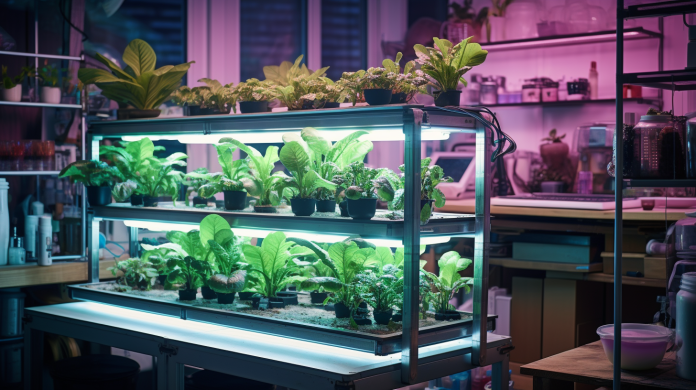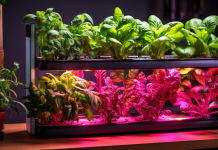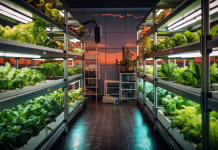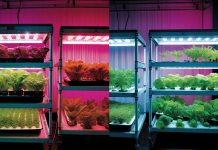Hydroponic gardening has gained popularity in recent years due to its efficiency and ability to produce high yields. One crucial factor in hydroponic systems is the choice of growing medium. This article is about exploring different hydroponic growing media, such as coco coir, rockwool, expanded clay pebbles, perlite, vermiculite, sand, and gravel.
By examining the advantages and disadvantages of each medium, hydroponic growers can make informed decisions to optimize their plant growth and maximize their harvest.
The Benefits of Coco Coir as a Hydroponic Growing Medium
Highlighting the numerous advantages of utilizing coco coir as a hydroponic growing medium includes its exceptional water retention capabilities. Coco coir, derived from the fibrous husk of coconuts, has the ability to hold a significant amount of water while still providing adequate aeration for plant roots. This is crucial for hydroponic systems, where plants rely on nutrient-rich water rather than soil for their growth.
The water retention properties of coco coir ensure that plants have access to a steady supply of moisture, reducing the risk of dehydration and allowing for more efficient nutrient uptake. Additionally, coco coir is a sustainable and renewable resource, making it an environmentally friendly choice for growers. Its pH neutrality and resistance to diseases and pests also contribute to its popularity as a hydroponic growing medium.
Exploring the Versatility of Rockwool in Hydroponic Systems
Rockwool, a popular hydroponic growing medium, offers a wide range of applications and benefits in hydroponic systems.
This versatile growing medium is made from molten rock spun into fibers, creating a lightweight and porous material.
One of the main advantages of rockwool is its excellent water retention capabilities, allowing for optimal moisture levels in the root zone.
It also provides good insulation, preventing heat loss and maintaining stable temperatures for plant growth. Furthermore, rockwool has a neutral pH, which can be easily adjusted to suit the specific needs of different plant species.
Its fibrous structure promotes strong root growth and provides excellent support for plants.
Additionally, rockwool is reusable and recyclable, making it an environmentally friendly option for hydroponic growers. With its versatility and numerous benefits, rockwool is a valuable choice for hydroponic systems.
Understanding the Advantages and Disadvantages of Expanded Clay Pebbles
One of the key benefits of using expanded clay pebbles as a hydroponic growing medium is their lightweight nature, which allows for easy handling and manoeuvrability in the system. Expanded clay pebbles, also known as hydroton or clay balls, are made from clay that has been heated and expanded. This process creates a porous and lightweight material that is ideal for hydroponic systems.
However, like any growing medium, expanded clay pebbles have their advantages and disadvantages. The table below provides a summary of these:
| Advantages | Disadvantages |
| Lightweight and easy to handle | – Can be expensive compared to other growing media |
| Provide good aeration and drainage | – Require regular cleaning and maintenance to prevent clogging |
| Have a neutral pH level | – Limited water holding capacity |
| Can be reused multiple times | – May require additional support for heavy plants |
While expanded clay pebbles offer several benefits for hydroponic growers, it is important to consider these disadvantages and determine if they align with the specific needs of your growing system.
An In-Depth Look at the Pros and Cons of Perlite in Hydroponics
Perlite, a popular hydroponic growing medium, offers a range of advantages and disadvantages that are worth examining in detail. Here are four key points to consider:
- Lightweight: Perlite is extremely lightweight, making it easy to handle and transport. This is especially beneficial for large-scale hydroponic systems.
- Excellent Drainage: Perlite has excellent drainage properties, allowing water to flow freely through the medium. This prevents waterlogging and ensures adequate oxygenation of the roots.
- pH Neutral: Perlite has a neutral pH, which means it does not significantly affect the acidity or alkalinity of the nutrient solution. This makes it versatile and suitable for a wide range of plants.
- Limited Nutrient Holding Capacity: While perlite provides good drainage, it has limited nutrient holding capacity. This means that plants grown in perlite may require more frequent nutrient solution applications to ensure adequate nutrition.
The Role of Vermiculite in Hydroponic Growing: Benefits and Considerations
Vermiculite, a versatile hydroponic growing medium, offers numerous benefits. This lightweight and porous material is derived from a natural mineral and is commonly used in hydroponic systems.
One of the key benefits of using vermiculite is its excellent water retention capacity. It can hold water and nutrients, ensuring that plants have a constant supply for optimal growth.
Additionally, vermiculite has good aeration properties, allowing roots to access oxygen easily. This helps prevent root rot and promotes healthy root development. Another advantage of vermiculite is its neutral pH, which makes it suitable for a wide range of plants.
However, it is important to note that vermiculite does not provide any nutrients to the plants, so it must be used in conjunction with a nutrient solution. Moreover, vermiculite can break down over time, so it may need to be replaced periodically.
Despite these considerations, vermiculite remains a popular choice among hydroponic growers due to its versatility and beneficial properties.
Examining the Use of Sand as a Hydroponic Growing Medium
Sand, along with other hydroponic growing media, offers a variety of advantages and considerations that warrant further examination. Here are four key points to consider when using sand as a hydroponic growing medium:
- Drainage: Sand has excellent drainage properties, allowing excess water to flow through and preventing waterlogged roots.
- Aeration: The loose structure of sand promotes good airflow, ensuring adequate oxygen supply to the roots.
- Stability: Sand provides stability for plants, preventing them from toppling over and offering support during growth.
- Nutrient holding capacity: While sand does not have high water or nutrient holding capacity, it can be mixed with other media to enhance these properties.
While sand is an option as a growing medium, its physical and chemical properties may pose challenges in maintaining an optimal environment for plant growth in a hydroponic system. It might be beneficial to consider other growing mediums or mix sand with other mediums.
Gravel as a Hydroponic Growing Media: Exploring Its Effectiveness and Limitations
Gravel, yet often overlooked as a hydroponic growing media, has proven to be both effective and versatile in various hydroponic systems. While other growing media such as coco coir and sand have gained more popularity, gravel offers its own set of advantages.
One of the key benefits of using gravel as a growing medium is its excellent drainage properties. The porous nature of gravel allows excess water to drain easily, preventing the roots from becoming waterlogged and promoting healthy root growth. Additionally, gravel provides stability to the plants, preventing them from toppling over.
However, there are also limitations to using gravel as a growing medium. It has a limited water holding capacity, which means that plants may require more frequent watering. Furthermore, the size of the gravel particles can affect the root penetration and overall plant growth.
Despite these limitations, gravel remains a viable option for hydroponic growers looking for a cost-effective and easy-to-use growing media.
Conclusion
- Coco Coir and Rockwool are hydroponic growing media made from natural materials with excellent water retention capabilities and good aeration for plant roots. They need their pH levels adjusted before use and can be reused multiple times.
- Expanded Clay Pebbles and Gravel are lightweight hydroponic growing media that provide good drainage and stability to plants. Expanded clay pebbles allow for good oxygenation of roots and can be reused multiple times. Both media require pH adjustment before use.
- Perlite is a lightweight hydroponic growing media made from volcanic glass. It provides good drainage and improves aeration in the root zone. pH adjustment is necessary before use and it can be mixed with other media for better results.
- Vermiculite is a hydroponic growing media with excellent water retention capacity and good aeration properties. It has a neutral pH suitable for various plants but does not provide nutrients and needs a nutrient solution. It may need periodic replacement.
In conclusion, exploring different hydroponic growing media allows for a greater understanding of their benefits, versatility, advantages, and limitations.
Each medium has its own unique characteristics that can be utilized based on specific hydroponic system requirements.
Please see our supporting article:
Hydroponics on a Budget: Affordable DIY Setup Ideas for Beginners



